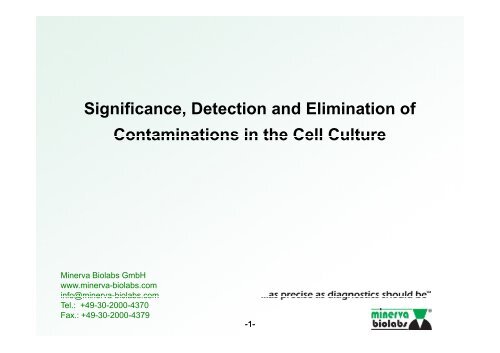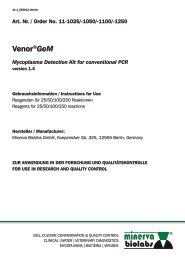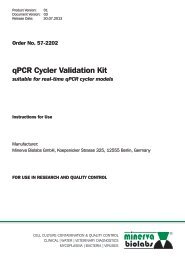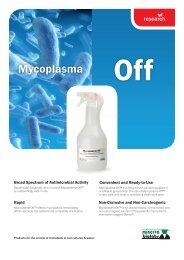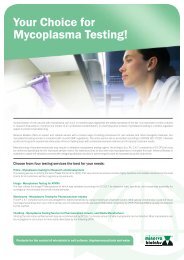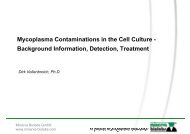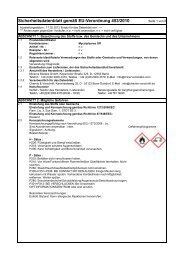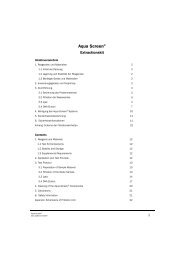Significance, Detection and Elimination of ... - Minerva Biolabs
Significance, Detection and Elimination of ... - Minerva Biolabs
Significance, Detection and Elimination of ... - Minerva Biolabs
You also want an ePaper? Increase the reach of your titles
YUMPU automatically turns print PDFs into web optimized ePapers that Google loves.
<strong>Significance</strong>, <strong>Detection</strong> <strong>and</strong> <strong>Elimination</strong> <strong>of</strong><br />
Contaminations in the Cell Culture<br />
<strong>Minerva</strong> <strong>Biolabs</strong> GmbH<br />
www.minerva-biolabs.com<br />
info@minerva-biolabs biolabs.com<br />
Tel.: +49-30-2000-4370<br />
Fax.: +49-30-2000-4379<br />
-1-
The Usual Suspects<br />
• Contamination with other cell lines<br />
• Yeast<br />
• Fungi<br />
• Viruses:<br />
especially bovine Pestiviruses<br />
BVDV – Virus <strong>of</strong> Bovine Virus diarrhea<br />
CSFV – Virus <strong>of</strong> the classical swine<br />
but also BDV (Borna Disease Virus)<br />
• Bacteria<br />
• Mycoplasma<br />
-2-
Cross-contamination<br />
The contamination <strong>of</strong> a cell line with a cells from another type<br />
• Avoidance:<br />
Only one cell line under the clean bench at a time<br />
Separate medium bottles for each cell line<br />
• <strong>Detection</strong>:<br />
Difficult, especially with cell line <strong>of</strong> comparable morphology<br />
Indications are changes in growth rates, morphology <strong>of</strong> prduct characterisation as well as<br />
not reproducable results<br />
Applicable detection techniques: Isoenzyme pattern analysis, DNA sequencing, Southern<br />
blot bo analysis ayss<br />
-3-
The Usual Suspects<br />
• Contamination with other cell lines<br />
• Yeast<br />
• Fungi<br />
• Viruses:<br />
especially bovine Pestiviruses<br />
BVDV – Virus <strong>of</strong> Bovine Virus diarrhea<br />
CSFV – Virus <strong>of</strong> the classical swine<br />
but also BDV (Borna Disease Virus)<br />
• Bacteria<br />
• Mycoplasma<br />
-4-
Yeast<br />
unicellular fungi<br />
size can vary greatly depending<br />
on the species, typically<br />
measuring 3–4 µm in diameter<br />
smaller than eukaryotic cells<br />
curable, but not recommended<br />
antimycotics Amphotericin B <strong>and</strong> Nystatin<br />
-5-
The Usual Suspects<br />
• Contamination with other cell lines<br />
• Yeast<br />
• Fungi<br />
• Viruses:<br />
especially bovine Pestiviruses<br />
BVDV – Virus <strong>of</strong> Bovine Virus diarrhea<br />
CSFV – Virus <strong>of</strong> the classical swine<br />
but also BDV (Borna Disease Virus)<br />
• Bacteria<br />
• Mycoplasma<br />
-6-
Fungi<br />
Medium color turns yellow quickly<br />
Under the microscope detectable as a<br />
cotton-like fluff<br />
Treatment with antimycotics possible at early stage<br />
contamination<br />
With fluffs strong spore formation expected:<br />
Do not open ⇒ destroy immediately!<br />
-7-
The Usual Suspects<br />
• Contamination with other cell lines<br />
• Yeast<br />
• Fungi<br />
• Viruses:<br />
especially bovine Pestiviruses<br />
BVDV – Virus <strong>of</strong> Bovine Virus diarrhea<br />
CSFV – Virus <strong>of</strong> the classical swine<br />
but also BDV (Borna Disease Virus)<br />
• Bacteria<br />
• Mycoplasma<br />
-8-
Contamination with Pestivirus<br />
• BVDV typical bovine infection<br />
i<br />
• Contamination via sera: 20-30 % <strong>of</strong> raw sera, up to 49 % in<br />
commercially available sera<br />
• Testing via cell culture <strong>and</strong> CPE on indicator cell lines<br />
• No statistics regarding the contamination <strong>of</strong> cell cultures available<br />
-9-
Impact <strong>of</strong> Pestiviruses<br />
Diagnosticsi<br />
false-positive results with virus detection via plaque formation<br />
Vaccine-production<br />
Bovine viral diarrhoea virus antigen in foetal calf serum batches <strong>and</strong> consequences <strong>of</strong><br />
such contamination for vaccine production.<br />
Makoschey B, van Gelder PT, Keijsers V, Goovaerts D., Biologicals. 2003<br />
Sep;31(3):203-8.<br />
Fermentation/cell production<br />
R&D<br />
Diagnostic dilemma encountered when detecting bovine viral diarrhea virus in IVF<br />
embryo production. Given MD, Riddell KP, Galik PK, Stringfellow DA, Brock KV,<br />
Loskut<strong>of</strong>f NM. Theriogenology. 2002 Oct 15;58(7):1399-407.<br />
-10-
The Usual Suspects<br />
• Contaminations with other cells<br />
• Yeast<br />
• Fungi<br />
• Viruses:<br />
especially bovine Pestiviruses<br />
BVDV – Virus <strong>of</strong> Bovine Virus diarrhea<br />
CSFV – Virus <strong>of</strong> the classical swine<br />
but also BDV (Borna Disease Virus)<br />
• Bacteria<br />
• Mycoplasma<br />
-11-
Relevance <strong>of</strong> Bacteria Contaminations<br />
• contamination i due to impure techniques <strong>and</strong> source materials<br />
• typically recognized via organoleptic test<br />
(turbidity, coloration <strong>of</strong> the media turns yellow)<br />
• Approx. 6 % <strong>of</strong> the cultures are unrecognized contaminated (180<br />
samples, 11 positive with Onar ® EUB)<br />
Caulobacter sp.<br />
Methylophilus sp.<br />
Staphylococcus epidermis<br />
Methylobacterium sp.<br />
• Not recognized due to antibiotica in<br />
the cell culture media<br />
• No cure possible ⇒ Destroy!<br />
-12-
Bacteria Contamination - Examples<br />
• Blood bottles<br />
• Organ culture<br />
Incidence <strong>of</strong> bacterial <strong>and</strong> fungal contamination <strong>of</strong> donor corneas preserved by organ culture.Lagenah M, Bohnke<br />
M, Engelmann K, Winter R. Cornea. 1995 Jul;14(4):423-6.<br />
• Fermentation/cell culture<br />
Safety <strong>of</strong> biological products prepared from mammalian cell culture. DNA. Dev Biol St<strong>and</strong>. 1998;93:136-8.<br />
• Tissue Engineering<br />
Microbial contamination <strong>of</strong> cellular products for hematolymphoid transplantation therapy: assessment <strong>of</strong> the<br />
problem <strong>and</strong> strategies to minimize the clinical impact. Lowder JN, Whelton P., Cytotherapy. 2003;5(5):377-90.<br />
Endogenous microbial contamination <strong>of</strong> cultured autologous preparations in trials <strong>of</strong> cancer immunotherapy.Padley<br />
DJ, Greiner CW, Heddlesten TL, Hopkins MK, Maas ML, Gastineau DA. Cytotherapy. 2003;5(2):147-52.<br />
• R&D<br />
Cell culture contamination by mycobacteria. Buehring GC, Valesco M, Pan CY. In Vitro Cell Dev Biol Anim. 1995<br />
Nov;31(10):735-7.<br />
-13-
Bacteria <strong>Detection</strong> with Onar ® EUB<br />
One-step PCR with conventional gel evaluation<br />
Needs EUB Polymerase or other DNA-free polymerases<br />
<strong>Detection</strong> limit: 6 genomes/µl<br />
Specific for more than 45 bacteria<br />
Includes positiv control <strong>and</strong> internal amplification control.<br />
yes/no-result after 3 hours<br />
Package sizes: 25, 50, 100 und 250 tests, aliquotes á 25 tests.<br />
Aliquots <strong>of</strong> Master-MixMix with hot-start Taq possible.<br />
-14-
Analysis using Onar ® EUB<br />
1 kb DNA ladder<br />
positive control amplification<br />
internal control amplification<br />
positive sample / strong contamination<br />
positive sample / moderate contamination<br />
positive sample / weak contamination<br />
negative sample with internal control<br />
-15-
The Usual Suspects<br />
• Contaminations with other cells<br />
• Yeast<br />
• Fungi<br />
• Viruses:<br />
especially bovine Pestiviruses<br />
BVDV – Virus <strong>of</strong> Bovine Virus diarrhea<br />
CSFV – Virus <strong>of</strong> the classical swine<br />
• But also: BDV (Borna Disease Virus)<br />
• Bacteria<br />
• Mycoplasma<br />
-16-
Mycoplasma<br />
• Found in1898 classified as virus<br />
• Bacteria, origin in gram-positive Bacillus/Lactobacillus/<br />
Streptococcus line, but own class<br />
• Colloquial: Mycoplasma or PPLO (pleuropneumonia-like organism)<br />
• Class <strong>of</strong> Mollicutes (s<strong>of</strong>t skin) with the families:<br />
‣ Mycoplasmataceae: Mycoplasma (animal), Ureaplasma (animal)<br />
‣ Acholeplasmataceae: Acholeplasma (animal, plant)<br />
‣ Spiroplasmataceae: Spiroplasma (plant, anthropodes, rodent)<br />
‣ Anaeroplasma (ruminant)<br />
-17-
Mycoplasma (continued)<br />
• Pass cellulose- <strong>and</strong> polyvinyl filter with 0,45 µm pore width<br />
• Smalles, self-replicating organisms (0,3 to 0,8 µm, 600 kb to 1700<br />
kb (1/5 <strong>of</strong> E. coli-genome) with approx. 500 genes<br />
• Need to consume cholesterol, amino acids, fatty acids, vitamins <strong>and</strong><br />
other catabolites<br />
• Typically arginine, i glucose or urea metabolism<br />
• Lacks cell wall, but has simple plasma membrane<br />
– extremely flexible in relation to environment, however sensitive in relation to<br />
chemical influences<br />
– resistant to penicillin, contains no peptido glycan wall<br />
– osmotically unstable<br />
• occurring extra cellularly<br />
-18-
Mycoplasma (continued)<br />
• Parasites for humans, animals, plants, insects, etc.<br />
• Effects latent infections <strong>of</strong> human beings<br />
respiratory tract : M. pneumoniae<br />
genital tract: M. genitalium, Ureaplasma urealyticum, M. hominis<br />
joints: M. fementans, M. arthritidis<br />
zentral nerve system: M. pneumoniae<br />
heart: M. pneumoniae<br />
• Effects on plants:<br />
blossom greening (clover, strawberry)<br />
yellowing, stall (vine, pear, ster)<br />
midget growth (rice)<br />
sproud shooting (appel)<br />
transfer by cicada <strong>and</strong> leaf fleas<br />
-19-
Mycoplasma<br />
awaited the development <strong>of</strong> the cell culture<br />
in order to find their actual biological i l niche.<br />
-20-
Mycoplasma in the Electron Microscope<br />
Bovince cell line MDBK<br />
(a) without <strong>and</strong> (b) with Mycoplasma<br />
Source: Lünsdorf & Rohde,<br />
GBF Braunschweig<br />
BG Chemistry BookletB 004<br />
-21-
Frequency <strong>of</strong> Mycoplasma in Cell Cultures<br />
80%<br />
70%<br />
Ref.: S. Rottem, M. Wormser<br />
60%<br />
50%<br />
5 % in industry<br />
47 % in academics<br />
40%<br />
30%<br />
20%<br />
10%<br />
0%<br />
Deutschl<strong>and</strong> USA Japan Israel Argentinien<br />
-22-
Effects on Cell Culture<br />
• Inhibition <strong>of</strong> cell proliferation up to 50% by nutrient withdrawal <strong>and</strong><br />
secretion <strong>of</strong> harmful metabolic products<br />
McGarrity et al. (1984) In Vitro Cell. Dev. Biol. 20:1<br />
• fast glucose reduction <strong>and</strong> formation <strong>of</strong> acids => p H shift<br />
• arginine depletion => inhibition <strong>of</strong> protein biosynthesis, cell division <strong>and</strong> growth<br />
• Influence <strong>of</strong> immunological reactions<br />
(macrophage activation, inhibition <strong>of</strong> antigen presentation, induction <strong>of</strong> signal transduction)<br />
Mühlradt et al. (1996) Biochemistry 35:7781<br />
• Influence <strong>of</strong> virus proliferation <strong>and</strong> the infection rate<br />
Nar-Paz et al.(1995) FEMS Microbiol. Lett. 128:63<br />
• Cause chromosomal aberrations <strong>and</strong> multiple translocations<br />
McGarrity et al. (1978) In: Mycoplasma infection <strong>of</strong> cell cultures. Plenum Press S. 213ff<br />
• Disturbance <strong>of</strong> the hybridoma technique, contaminated cells become<br />
sensitive in HAT medium<br />
-23-
Effects on Cell Cultures (continued)<br />
• Accumulation <strong>of</strong> mycoplasma at cells wall alters cell wall integrity<br />
• Significant changes in micro array <strong>and</strong> gene expression pr<strong>of</strong>iles<br />
bioinformatics.picr.man.ac.uk/experiments/mycoplasma/<br />
• Mycoplasma can constitute up to 50% <strong>of</strong> the total protein <strong>and</strong> 15-<br />
30% <strong>of</strong> the isolated DNA<br />
• Decrease <strong>of</strong> the transfection rates by 5% through electroporation<br />
• Induction <strong>of</strong> leopard cells (condensation <strong>of</strong> the chromatins)<br />
Influence almost all functions <strong>of</strong> the host cell metabolism<br />
-24-
Frequency <strong>and</strong> Source <strong>of</strong> Mycoplasma Species<br />
Occurring in Cell Cultures (Literature comparison)<br />
20,22 %<br />
25,3 %<br />
A. laidlawii<br />
others<br />
9%<br />
18% M. argininii<br />
17%<br />
M. hominis<br />
5%<br />
M. hyorhinis<br />
20% M. fermentans<br />
3%<br />
M. salivarium<br />
5%<br />
36,9 %<br />
M. orale<br />
23%<br />
-25-
Sources <strong>of</strong> Contamination<br />
• Primary cultures from the original tissue<br />
(incidence approximately 4 %)<br />
• Cross contamination<br />
• contaminated cultures<br />
• new cultures from unknown sources, also partly from cell banks<br />
• virus suspensions, antibody- solutions or other additions <strong>of</strong> contaminated cell<br />
cultures<br />
• Direct contamination<br />
• serum (only treated serums, e.g. UV or γ-radiated are presumably mycoplasma<br />
free)<br />
• laboratory instruments, media <strong>and</strong> reagents, which came into contact with<br />
contaminated cultures<br />
-26-
Sources <strong>of</strong> Contamination (continued)<br />
• The User<br />
• direct entry while h<strong>and</strong>ling, usually from the oral flora<br />
• droplet transfer<br />
• lacking disinfection<br />
• careless technical work<br />
From:Toni Lindl, Zell-und Gewebekultur<br />
-27-
Importance <strong>of</strong> the Mycoplasma Tests<br />
• Cell cultures <strong>of</strong>fer ideal living conditions to parasitic mycoplasma:<br />
contamination is possible at any time<br />
• Despite titers from 10 7 to 10 8 mycoplasma/ml in cell cultures, no<br />
apparent projection referring to the contaminating mycoplasma<br />
species <strong>and</strong> the cell type<br />
• Microscopically i unrecognizable<br />
• St<strong>and</strong>ard antibiotics can allow contamination levels lower than<br />
detection levels, Pen/Strep does not provide protection from<br />
contamination<br />
!! only each 10th cell culture user regularly tests<br />
for mycoplasma contamination !!<br />
-28-
Instruction for Testing<br />
• Regulations:<br />
FDA Points to Consider (May 1993), Regularien 21CFR610.30<br />
USDA federal code #9CFR113.28<br />
European Pharmacopoeia 2.6.7, Suppl. 5.8<br />
ICH Guideline for biotechnological/biological products<br />
• Obliged to test:<br />
Master cell cultures, cell cultures, virus stocks, control cell cultures<br />
Bioproducts from cell cultures (antibodies, hormons, immune stimulators, blood<br />
products from cell cultures)<br />
Vaccines for humans <strong>and</strong> the veterinary field<br />
• Test necessary for:<br />
Editors who are aware <strong>of</strong> the significance <strong>of</strong> mycoplasma contamination<br />
-29-
Fluorescence method<br />
• Simple, direct indicator for vital<br />
mycoplasma<br />
• Little operative expense, but very time<br />
consuming<br />
• Poor indicator for mycoplasma species with<br />
tendencies <strong>of</strong> extra cellular cell absorption<br />
via cytadherent proteins<br />
• Seminars <strong>and</strong> experience required<br />
• Eur. Ph.-listed evidence<br />
-30-
Culture method<br />
• Strict requirements for the culture<br />
medium <strong>and</strong> growth conditions<br />
(aerobic/anaerobic), generally requires<br />
non-st<strong>and</strong>ard adjustments for the<br />
individual species<br />
• Extremely long testing times <strong>of</strong> 1 to 4<br />
weeks<br />
• Difficult analysis<br />
• Broth <strong>and</strong> disk possible<br />
• Advantage: only living mycoplasma is<br />
detected<br />
• Sensitivity: 1 CFU corresponds to<br />
average 30 GU<br />
M. argininii<br />
Source: Mycoplasma Experience Ltd.<br />
bar = 1 mm<br />
-31-
NAT method<br />
• Nucleic acid amplication test with<br />
primers <strong>and</strong> commercial kits free <strong>of</strong><br />
choice<br />
• Eur. Ph. 2.6.7, v 5.8, valid since 01.<br />
July 2007<br />
• Validation must show equality to<br />
established methods according<br />
sensitivity, specificity, <strong>and</strong> robustness<br />
• Can replace indicator methods if<br />
sensitivity below 100 cfu/ml<br />
• Can replace culture method if<br />
sensitivity is below 10 CFU/ml<br />
• Can replace both methods if results<br />
are required quickly<br />
• Cell culture enrichement possible to<br />
increase sensitivity<br />
-32-
Alternative Mycoplasma Diagnostic Methods<br />
Method<br />
Biochemical Verification Methods<br />
combined with luminescence detection<br />
Biochemical Verification Methods<br />
Adenosinphosphorylase osp o Test<br />
(6-MPDR-Test)<br />
Enzyme Immuno Verification<br />
Necessary Devices <strong>and</strong> Evaluation<br />
requires luminescence reader, low sensitivity<br />
<strong>of</strong> approx. 10 5 CFU per test, high dem<strong>and</strong>s<br />
for sample quality<br />
easy usable<br />
none / requires indicator cell line, low<br />
sensitivity, easily performed<br />
ELISA-Reader / specific for mycoplasma<br />
species, intermediate sensitivity (10 6 /ml),<br />
time intensive<br />
-33-
Requirements <strong>of</strong> a Modern Mycoplasma Test<br />
• Specificity for the “typical“ mycoplasma species<br />
• Unique <strong>and</strong> sensitive result<br />
• Applicable for diverse sample material<br />
• Fast <strong>and</strong> time saving<br />
• Samples directly testable<br />
• Simple, without intensive study <strong>of</strong> the laboratory personnel<br />
• Flexible, applicable for small <strong>and</strong> large sample numbers<br />
• Applicable also for simple laboratory configurations<br />
-34-
Performance<br />
Sample<br />
DNA-Extraction<br />
PCR<br />
Time: 120 - 180 min<br />
H<strong>and</strong>s-on: approx. 30 min<br />
Gel electrophoresis<br />
-35-
Transport <strong>and</strong> Stability - Guidelines<br />
• Non-treated at 4°C: max. 24 hours<br />
• After heat treatment (5 min, 95 °C) or DNA extraction<br />
at RT: approx. 3-4 days,<br />
at + 2-8 °C: approx. 2 weeks<br />
at< -18 °C: > 1 year<br />
-36-
Preparation <strong>of</strong> the Venor ® GeM Kit Components<br />
• Lyophylised components<br />
• Primer/Nucleotides<br />
• Positive Control<br />
• Internal Control<br />
• Rehydration procedure<br />
1. Centrifugation<br />
2. Addition <strong>of</strong> water<br />
3. Incubation<br />
4. Vortex<br />
5. Centrifugation<br />
• Storage<br />
unopened kit at + 2-8 °C<br />
after rehydration all components below - 18 °C<br />
-37-
PCR Mastermix<br />
• The correct order<br />
1. Water<br />
2. Buffer<br />
3. Other components<br />
• Important!<br />
• Do not vortex Taq polymerase<br />
• Mix your reaction samples<br />
• Aliquot <strong>and</strong> then add your sample<br />
• Mix <strong>and</strong> centrifuge<br />
-38-
Features <strong>of</strong> Venor ® GeM<br />
• Validated according to Eur. Ph. 2.6.7, 5.8<br />
• Recommended by the WHO<br />
• More than 100x cited in publications<br />
• Specific for > 25 mycoplasma species<br />
• <strong>Detection</strong> limit 1,5 copies/µL, LOD 95% = 4,5 copies/µl<br />
• Clear yes/no-result after 3 hours<br />
• Package sizes: 25, 50, 100 und 250 tests, t<br />
• User friendly aliquotes á 25 tests.<br />
• Aliquots <strong>of</strong> Master-Mix can be stored frozen<br />
including hot-start Taq possible.<br />
• Also available for real-time PCR<br />
-39-
Analysis using Venor ® GeM<br />
100 bp DNA ladder<br />
negative control / internal control amplification<br />
100.000 copies<br />
10.000 copies<br />
1000 copies<br />
100 copies<br />
10 copies<br />
1 copy<br />
-40-
Frequency <strong>of</strong> Testing<br />
• New cell <strong>and</strong> virus cultures<br />
• Each month for continuous cell lines; each week in cases <strong>of</strong><br />
laboratory contamination<br />
ti<br />
• Before each liquid nitrogen storage<br />
• Upon modification <strong>of</strong> the cell characteristics<br />
• In case <strong>of</strong> problems with result reproducibility<br />
-41-
Procedure for Contaminated Cell Cultures/ Virus<br />
• Isolate the culture immediately (incubator <strong>and</strong> if possible autoclave)<br />
• Immediately lock <strong>and</strong> test cryo- conserves<br />
• Isolate all cryo-conserved samples<br />
• Inform all possible receipts<br />
• St<strong>and</strong>ard disinfection <strong>of</strong> the laboratory<br />
• Initiate immediately treatment with irreplaceable cells<br />
-42-
Mycoplasma <strong>Elimination</strong> Methods<br />
• Antibiotics<br />
average activity: Cipr<strong>of</strong>loxacin (Ciprobay, Ciproxin), Doxycyclin<br />
low activity: Plasmocin, Chloramphenicol, Clindamycin, Azithromycin, Clarithromycin,<br />
Tetracyclin, Tiamulin<br />
no activity: Penicillin, Streptomycin, Polymyxin, Vancomyin, Erythromycin<br />
(only active against some species), Cephalosporine, Sulfametaxol, G418<br />
(Geneticin, Gentamycin-Analogon), Bacitracin<br />
• Complement Fixation<br />
• Co-Cultivation with Macrophages<br />
• Physical <strong>and</strong> chemical methods<br />
heat inactivation at 40-42 °C<br />
photo inactivation with Hoechst 33258/5-Bromuracil<br />
liquid extraction<br />
• Autoclave<br />
-43-
Effective <strong>Elimination</strong> with Mynox ® Gold<br />
Basically no cytotoxicity<br />
Highly effective:<br />
up to 100% permanent elimination with first<br />
treatment<br />
Universal for cells<br />
Universal for Mycoplasma<br />
Low resistance risk<br />
Convenient Format<br />
Interoperable with other antibiotics<br />
-44-
Effect <strong>of</strong> Mynox ® on Mycoplasma<br />
Electron micrographs <strong>of</strong> mink lung cells (ML cells), contaminated with<br />
Mycoplasma hyorhinis<br />
Source: M. Özel, Robert-Koch-Institut Berlin<br />
-45-
Recommendations for the Improvement<br />
<strong>of</strong> Mycoplasma Contamination<br />
• Regularly <strong>and</strong> sensitive testing (monthly); weekly testing in cases<br />
<strong>of</strong> laboratory contamination<br />
• Operate free <strong>of</strong> st<strong>and</strong>ards antibiotics<br />
• Whenever possible: separate the work benches <strong>and</strong> incubators for<br />
h<strong>and</strong>ling contaminated <strong>and</strong> mycoplasma free materials<br />
• Never use contained cultures; reject immediately or treated<br />
• Disinfect working surfaces <strong>and</strong> h<strong>and</strong>s with alcoholic spray before<br />
<strong>and</strong> after working procedures, or with the change <strong>of</strong> the working<br />
material<br />
• Quarantine new cells <strong>of</strong> any origin <strong>and</strong> integrate into the<br />
laboratory only after testing negative<br />
• For larger loads <strong>of</strong> serum, incubate on indicator cells 3T3 or Vero<br />
over 4 passages before integration <strong>and</strong> use, <strong>and</strong> the test<br />
supernatants by means <strong>of</strong> PCR<br />
-46-


